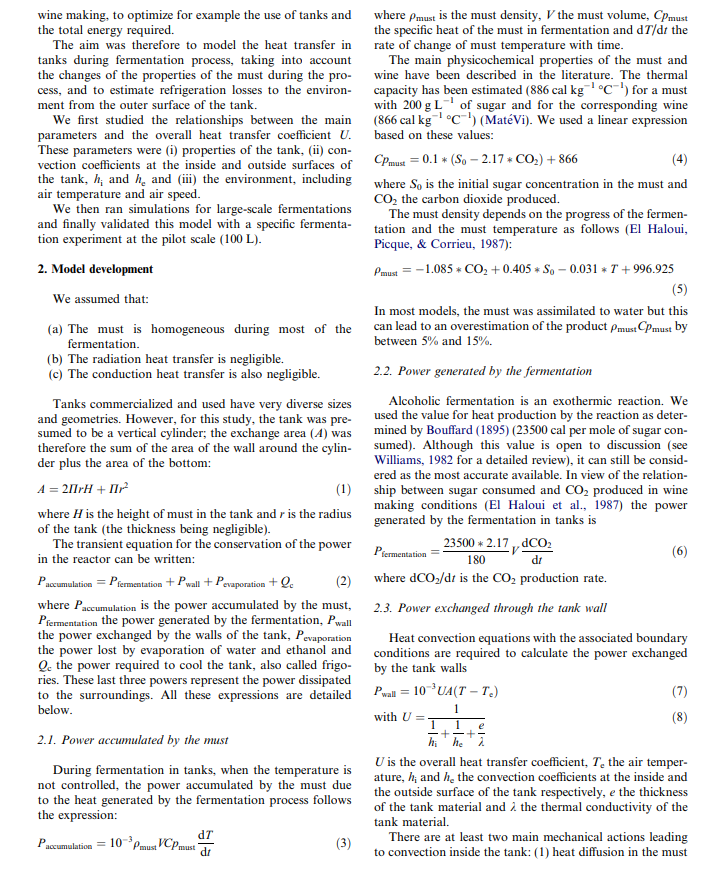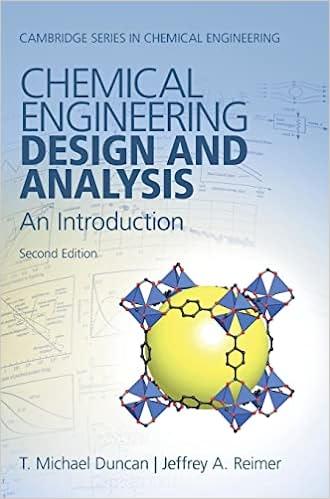

Q8: Assuming that a fermentation tank with volume 100 L is perfectly insulated, what is the temperature rise in the tank due to fermentation of 100 grams of sugar? Use the data provided on page 954 of Colombie et al. (uploaded to Canvas) for your estimate. You can assume that the density and specific heat capacity of the must are constant at 997 g/L and 866 cal/kg/C, respectively. [20 points] wine making, to optimize for example the use of tanks and where must is the must density, the must volume, CPmust the total energy required. the specific heat of the must in fermentation and dT/dt the The aim was therefore to model the heat transfer in rate of change of must temperature with time. tanks during fermentation process, taking into account The main physicochemical properties of the must and the changes of the properties of the must during the pro- wine have been described in the literature. The thermal cess, and to estimate refrigeration losses to the environ- capacity has been estimated (886 cal kg c-)) for a must ment from the outer surface of the tank. with 200 g 1"' of sugar and for the corresponding wine We first studied the relationships between the main (866 cal kg-oc-(MatVi). We used a linear expression parameters and the overall heat transfer coefficient U. based on these values: These parameters were (i) properties of the tank, (ii) con- vection coefficients at the inside and outside surfaces of Pmust = 0.1* (S. - 2.17* CO2) + 866 (4) the tank, h; and he and (iii) the environment, including where S, is the initial sugar concentration in the must and air temperature and air speed. We then ran simulations for large-scale fermentations CO, the carbon dioxide produced. The must density depends on the progress of the fermen- and finally validated this model with a specific fermenta- tion experiment at the pilot scale (100 L). tation and the must temperature as follows (El Haloui, Picque, & Corrieu, 1987): 2. Model development Pmust = -1.085 * CO2 +0.405 * $, -0.031 +1 +996.925 (5) We assumed that: In most models, the must was assimilated to water but this (a) The must is homogeneous during most of the can lead to an overestimation of the product Pmust must by fermentation between 5% and 15%. (b) The radiation heat transfer is negligible. (c) The conduction heat transfer is also negligible. 2.2. Power generated by the fermentation Tanks commercialized and used have very diverse sizes Alcoholic fermentation is an exothermic reaction. We and geometries. However, for this study, the tank was pre- used the value for heat production by the reaction as deter- sumed to be a vertical cylinder; the exchange area (A) was mined by Bouffard (1895) (23500 cal per mole of sugar con- therefore the sum of the area of the wall around the cylin- sumed). Although this value is open to discussion (see der plus the area of the bottom: Williams, 1982 for a detailed review), it can still be consid- ered as the most accurate available. In view of the relation- A = 2717H + IT? (1) ship between sugar consumed and CO2 produced in wine where H is the height of must in the tank and r is the radius making conditions (El Haloui et al., 1987) the power of the tank (the thickness being negligible). generated by the fermentation in tanks is The transient equation for the conservation of the power in the reactor can be written: 23500 + 2.17, CO2 Pfermentation 180 (6) di Paccumulation = Pfermentation + Pwall + Pevaporation + O. (2) where dCO,/dt is the CO2 production rate. where Paccumulation is the power accumulated by the must, 2.3. Power exchanged through the tank wall Pfermentation the power generated by the fermentation, Pwall the power exchanged by the walls of the tank, Pevaporation Heat convection equations with the associated boundary the power lost by evaporation of water and ethanol and conditions are required to calculate the power exchanged Qe the power required to cool the tank, also called frigo- by the tank walls ries. These last three powers represent the power dissipated to the surroundings. All these expressions are detailed Pwall = 10 UAT - T.) (7) below. with U 2.1. Power accumulated by the must hi'he During fermentation in tanks, when the temperature is U is the overall heat transfer coefficient, T. the air temper- not controlled, the power accumulated by the must due ature, h; and he the convection coefficients at the inside and to the heat generated by the fermentation process follows the outside surface of the tank respectively, e the thickness of the tank material and the thermal conductivity of the the expression: tank material. dr Pacumulation = 10 m VCpmat (3) There are at least two main mechanical actions leading di to convection inside the tank: (1) heat diffusion in the must 1 + e + Pmust








